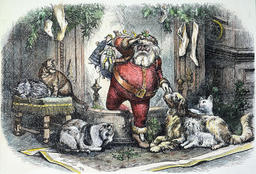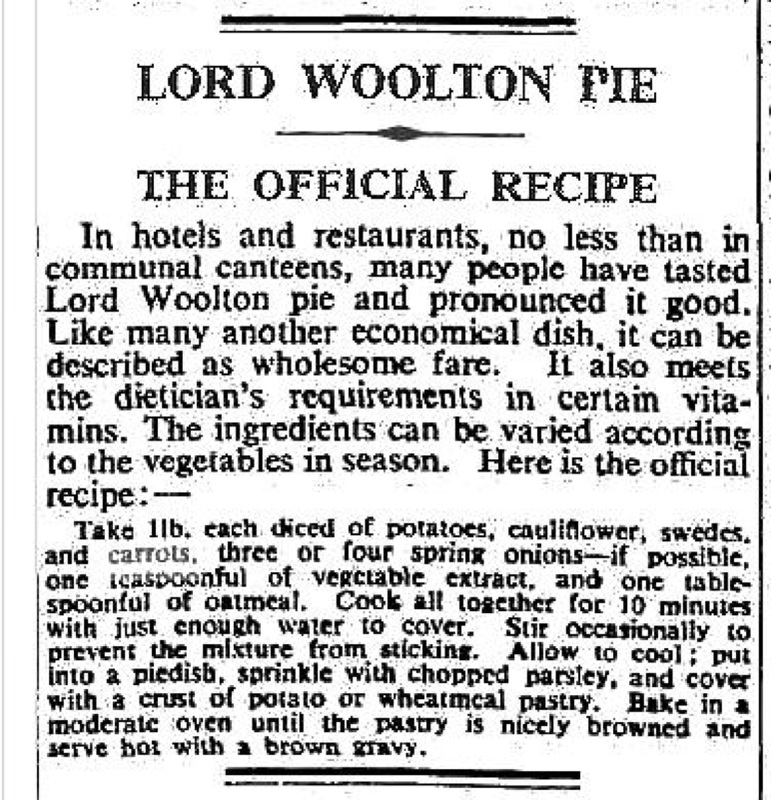|
Here is the recipe for Lord Woolton pie, the staple of WW2 rationing and just the thing for Dad's Army!
Take 1Ib each of diced potatoes, cauliflower, swedes and carrots; Three or Four spring onions; One teaspoonful of vegetable extract and One teaspoonful of oatmeal. Cook all together for ten minutes with just enough water to cover. Stir occasionally to prevent the mixture from sticking. Allow to cool; put into a pie dish, sprinkle with chopped parsley and cover with a crust of potatoes or wholemeal pastry. Bake in a moderate oven until the pastry is nicely brown and serve hot with brown gravy.
1 Comment
Glires - the Roman delicacy of stuffed dormice. This recipe was written by Marcus Gaius Apicius. Dormice are both endangered and cute so please use chicken breasts instead.
Glires: isicio porcino, item pulpis ex omni membro glirium trito, cum pipere, nucleis, lasere, liquamine farcies glires, et sutos in tegula positos mittesin furnum aut farsos in clibano coques. Dormice: Is stuffed with a forcemeat of pork and small pieces of dormouse meat trimmings, all pounded with pepper, nuts, laser, broth. Put the dormouse thus stuffed in an earthen casserole, roast it in the oven, or boil it in the stock pot. Ingredients: 2 chicken breasts 500g forcemeat (made from sausagemeat, 100g breadcrumbs and chicken breast meat trimmings) 50g chopped nuts 80g Asafoetida (or 6 garlic cloves) 50ml chicken stock olive oil for frying salt and pepper to taste Trim the chicken breast to mouse-shapes & use the chopped trimmings for the forcemeat. Cut a pocket in the breast large enough to hold the stuffing. Add any meat trimmings to the forcemeat. Add the nuts, Asafoetida (or garlic cloves) and pepper to a mortar and use a pestle to create a smooth paste. Add the chopped meat to this and mix thoroughly. Pour in a little of the stock and a drizzle of olive oil on this and mix well. Use this meat mixture to stuff the chicken breasts and either roast in an oven at 180°C for 20–25 minutes or by boiling in stock for 30–40 minutes. If using chicken breasts place these on a plate with the fat (tail) ends facing inwards. Decorate the narrow (head) end with berries for eyes and chives for whiskers to make them look more mouse-like & cute. This Tudor recipe was proffered by Jennifer Porrett, @fenifur on Twitter. It was first published by A.W. in 1584 and reprinted by Edward Allde in 1591.
To bake a Pig like a Fawne. Fley him when he is in the haire, season it with pepper and salt, Cloves and mace, take Claret wine, Vergious, Rosewater, Sinamon, Ginger and Sugar, boyle them togither, laye your Pig flat like a Fawne or a Kidde, and put your sirup unto it and sweet butter, and so bake it leisurely. ('Vergious' means verjuice, a soured grape juice. Substitute it with a bit of red wine vinegar. - Matthew) Having plumed and cleaned your chickens, cut them in half, truss them and pound them with the flat of a big knife: then put them in a pot with good butter and melted lard, some slices of lemon, elephant garlic and all sorts of fines herbes, except thyme and laurel; cook and simmer all this slowly over a low fire with a little good bouillon, then put in a glass of Champagne, or of good white wine: when they are almost cooked, take them out of the pot, bread them well and grill them, and serve them as is or with a Remoulade. Massialot’s Cuisinier Royal et Bourgeois (1705)
For the sauce: Chop two or three shallots up very fine, a little chervil and some tarragon; put all this in the bottom of an earthen vessel with mustard, a trickle of vinegar, salt and pepper, depending on how much you need; sprinkle your suace lightly with oil, and stir it constantly; if you see that it thickens too much, put in a little vinegar; taste to see if it is properly salted; if it is too salty, put in a little more mustard and oil. Conyng, Mawlard, in gely or in cyuey. Take Conynge, Hen, or Mawlard, and roste hem alle-most y-now, or ellys choppe hem, an frye hem in fayre Freysshe grece; an frye myncyd Oynenons, and caste alle in-to the potte, & caste ther-to fayre Freysshe brothe, an half Wyne, Maces, Clowes, Powder pepir, Canelle; than take fayre Brede, an wyth the same brothe stepe, an draw it thorw a straynoure wyth vynegre; an whan it is wyl y-boylid, caste the lycoure ther to, & powder Gyngere, & Salt, & sesyn it vp an serue forth. 2kg rabbit, duck or chicken, jointed and cut up
1 onion, chopped 2 Tbsp. olive oil 250ml red wine 500ml chicken stock 1/2 tsp. black pepper 1/2 tsp. mace 1/4 tsp. ginger 1/4 tsp. cloves 1/4 tsp. cinnamon 60ml red wine vinegar salt 1/4 tsp. bread crumbs (2 slices worth) Seal meat in a large pot and set aside, using olive oil as required. Brown onions in remaining oil until tender. Return the meat to the pot and add wine, stock, mace, cloves, pepper, and cinnamon. Bring to a boil and simmer for 1 hour. Add bread crumbs, ginger, vinegar, and salt just before serving.  12/12/12 seems an auspicious day to reach a major landmark. Even the trees had bedecked themselves with glittering frost this morning in celebration of Matthew's @HistoryNeedsYou Twitter following passing the 10,000 mark. Thank you to all 10,000 plus of you, and here's to more historical knowledge, jollity, and friendships. A cup of tea and a slice of cake for one and all, wouldn't you say? Of course, one doesn't achieve a large social media following by chance. Success comes from delivering a carefully mixed, appetising cocktail of ingredients, and Matthew most certainly has the recipe. Social media is an increasingly powerful way of connecting with the people you need to influence, yet it is still an alien world to many. Happily, Matthew is able to pass on his recipe, adapted for your needs - whether you are a business, a heritage body or an individual - on engaging and interacting with your audience using social media. He will help to demystify it for you and show you how to use it to best advantage for your organisation. To learn how to TwitterBetter with Matthew, please get in touch to find out more by going to our Contact page or you can email info at historyneedsyou dot com. How to stew a Trout - from The English Huswife by Gervase Markham.
Take a large Trout fair trimm’d, and wash it, and put it into a deep pewter dish, then take half a pint of sweet Wine, with a lump of butter, & a little whole Mace, Parsley, Savory, & Thyme, mince them all small, and put them into the Trouts belly, and so let it stew a quarter of an hour, then mince the yelk of a hard Egg, and strew it on the Trout, and laying the herbs about it, and scraping on Sugar, serve it up. I have not translated this or added specific instructions as the original text is clear enough. This recipe is for jumballs - and is rather like a biscuit. They go well with wine.
The recipe is from The Compleat Cook, 1658 Take two pound of flower, dry it and season it very fine, then take a pound of Loaf Sugar, and beat it very fine, and searce it, mingle your Flower and Sugar very well, then take a pound and a halfe of sweet Butter and wash out the Salt, and breake it into bits with your Flower and Sugar, then take yolks of foure new laid Eggs, and four or five spoonfuls of Sack, and four spoonfuls of Creame; beat all these together, then put them into your Flower, and knead them to a Past, and make them into what fashion you please, and lay them upon Paper or Plates, and put them into the Oven, and be carefull of them, for a very little thing bakes them. For Jumbals you must only adde the whites of two or three Eggs.  Following Matthew's recent radio show about The History of Christmas for EGH Media, he has created a Pinterest board with some of the images he tweeted during the live show. Follow this link to visit the board - it tells the story of how Santa Claus became red. The History of Christmas radio show can be listened to using the audio player below. Listen to internet radio with EGH Media on Blog Talk Radio Tart de brymlent - a fish and fruit pie Take fyges & raysouns, & waisshe hem in wyne, and grinde hem smale with apples & peres clene ypiked. Take hem vp and cast hem in a pot wiþ wyne and sugur. Take calwer samoun ysode, oþer codlyng oþer haddok, & bray hem smal, & do þerto white powdours & hoole spices & salt, & seeþ it. And whanne it is sode ynowgh, take it vp and do it in a vessel, and lat it kele. Make a ciffyn an ynche depe & do þe fars þerin. Plaunt it above with prunes damysyns: take þe stones out; and wiþ dates quartered and piked clene. And couere the coffyn, and bake it wel, and serue it forth. Ingredients
Chopped figs Raisins Apples pears, peeled, cored, & chopped White wine Sugar Cooked Salmon, Cod, or Haddock meat, minced or shredded White Pepper Cinnamon Sticks, Black Peppercorns, Cloves, Ginger, Nutmeg. - wrapped up in a little bag Salt Raised pastry pie-case Pitted Prunes Dates, quartered Prunes Place the figs, raisins, apples, & pears in a large pot; cover with wine and add sugar to taste - it should be just slightly sweet, but not overly so. Add fish, spices, & salt to taste. Bring to a boil, then reduce heat to a simmer. Allow the mixture to cook until it has reduced and thickened. Remove the spices in cheesecloth. Remove the pot from the heat and let cool. Place the filling in the pie shell and arrange the prunes and dates on top. Cover with the pastry lid. Bake until pastry is a golden brown. Serve with bread and wine. |
Archives
January 2017
Categories
All
|
Copyright for all images and text on this website is owned by Matthew Ward Hunter and Gill Fraser Lee, @HistoryNeedsYou unless stated otherwise. Images and content may not be used elsewhere without permission.


 RSS Feed
RSS Feed